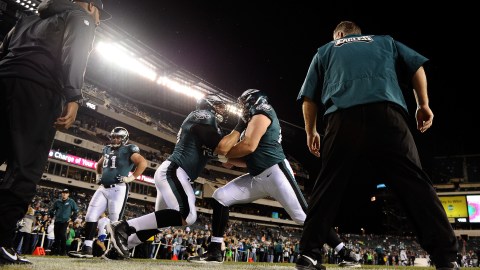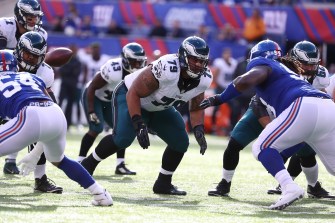Super Bowl LII: Are supersized linemen risking their health?

Super Bowl LII is nearing its kickoff on February 4th at 6:30PM EST and football pundits—professional and armchair alike—are busy speculating whether the New England Patriots or the Philadelphia Eagles will rise victorious.
And given that football is an athletic competition, it’s hard not to notice the sheer size of some players, particularly offensive linemen charged with protecting any team’s greatest asset: the quarterback.
Over the years, offensive linemen have gotten bigger and bigger, and health sciences from neurology to nutrition have reached new vistas. Concerns for player health have permeated the National Football League as a result.
The same football pundits talking gameday strategy are also wondering whether clinical obesity trades off with athletic prowess—let alone long term health concerns.
A league growing in girth
The heaviest player in Super Bowl I came in at 260 pounds. All offensive lines in modern NFL average players of over 300 pounds, with many being even bulkier, like the Raiders’ starting line which averaged 327 lbs per player in 2016.
While these players are clearly big and strong, are they potentially setting themselves up for health-related issues down the line?
The CDC defines “obesity” as having a Body Mass Index (BMI) of over 30. BMI, if you recall, is calculated by dividing the body’s mass by the square of the body height. How does obesity impact health? Often very negatively, leading to such illnesses as diabetes, high blood pressure, high cholesterol levels, heart attacks due to coronary heart disease, stroke, bone and joint problems, sleep apnea and some cancers. The host of potential problems associated with a high BMI calls the size of some modern football players into question. Are they risking ill health to keep up with the constantly increasing NFL player sizes?

Super Bowl I: Green Bay Packers Hall of Fame fullback Jim Taylor turns the corner with Kansas City Chiefs defensive tackle Andrew Rice in pursuit. (Credit: James Flores/Getty Images)
Let’s look at how the offensive lines of this year’s Super Bowl teams stack up. One can argue that the Philadelphia’s linemen have an advantage by combining superior size and speed.
A new athleticism: Eagles’ lineman mobility
As Robert Mays reports for The Ringer, the Philadelphia right tackle Lane Johnson has a physique “rarely seen for an offensive lineman.” He’s 6-foot-6 and weighs 303 pounds, which would give him the BMI of 35. While that’s technically “obese,” Johnson ran a 4.72 in the 40-yard dash (which puts him in the 99th percentile), has a 34-inch vertical leap (96th percentile), and pulled off a 118-inch broad jump (99th percentile). Mays says he’s arguably “the most athletic offensive line prospect this century.”
According to pre-draft workout data from Mockdraftable.com, Philadelphia’s center Jason Kelce, with a BMI of 36.9 (derived from his 6’3”, 295 pound frame), has the best 20-yard shuttle time (4.14 seconds) and the second-best three-cone drill time (7.22 seconds) in 18 years of data gathered by the site.
The third man of the formidable trio is the 6’5” right guard Brandon Brooks, who comes in at 346 pounds for a BMI of 41, which is defined as “high risk,” “extreme,” and “severe” obesity by the CDC. Brooks ran a 4.98-second 40-yard dash (putting him in the 93rd percentile) and a 1.71-second 10-yard split (90th percentile). That’s very fast for a man of his size.

Brandon Brooks #79 of the Philadelphia Eagles in action against the New York Giants during their game at MetLife Stadium on November 6, 2016 in East Rutherford, New Jersey. (Photo by Al Bello/Getty Images)
Left tackle Halapoulivaati Vaitai (6’6”, 320 lbs, 37 BMI) and left guard Stefen Wisniewski (6’3”, 305 lbs, BMI 38.1) complete the starting offensive line of the Eagles.
The Patriots line by comparison
To counter these guys, the Patriots have the linebacker Elandon Roberts (6’0”, 235 pounds, BMI 31.9) who ran a 4.6-second 40-yard dash in 2016 and inside linebacker Kyle Van Noy (6’3”, 243 lbs, 30.4 BMI), who ran the 40 in 4.71 seconds. As you can see, Roberts and Van Noy have similar athletic ability to the Eagle’s offensive trio but weigh significantly less, creating a potential mismatch.
The New England offensive linemen include the right tackle Cameron Fleming (6’6”, 320 lbs, 37 BMI), who ran a 5.28s 40-yard dash. While he has the same height, he is heavier and slower than Philly’s Lane Johnson.
The Patriot’s center David Andrews is exactly the size of Philly’s Kelce (6’3”, 295 lbs, 36.9 BMI), but has a much slower 4.78s time in the 20-yard shuttle. The right guard Shaq Mason (6’1”, 310 lbs, 40.9 BMI)has a similar BMI to Brandon Brooks of the Eagles, but weighs approximately 36 pounds less while running no faster than Brooks, putting in a 4.97 second 40-yard dash. Also like Brooks, he has the “severe” obese BMI of over 40.

Running back James White #28 of the New England Patriots celebrates a fourth quarter touchdown against the Denver Broncos with offensive guard Shaq Mason #69 of the New England Patriots at Sports Authority Field at Mile High on November 12, 2017 in Denver, Colorado. (Photo by Dustin Bradford/Getty Images)
Left tackle Nate Solder (6’8”, 325 lbs, 35.7 BMI) and left guard Joe Thuney (6’5”, 305 lbs, 36.2 BMI) complete the Patriots’ line.
—





